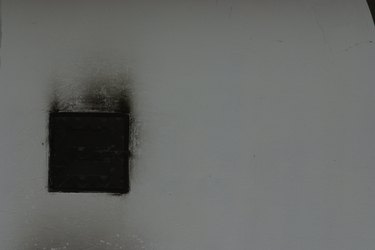
Whether you're cleaning up minor fire damage, gradual smoke buildup around a fireplace or accidental soot stains from a misplaced candle, it's important to remove all traces of black smoke stains from walls and other surfaces. Soot is not only an aesthetic problem but it also harbors unpleasant aromas that can linger for a long time. Further, tiny soot particles can be harmful to your health if you breathe them in, so tackle black smoke stains immediately and cautiously.
Resist the urge to immediately wipe smoke stains off a painted wall with water or regular household cleaning products because doing so can make the stains worse and can damage a painted finish. Instead, use water-free cleaning methods first and then turn to wet solutions for cleaning up any remaining stains.
Video of the Day
Video of the Day
Important Preparation Steps
If you're dealing with a large black smoke stain with lots of soot accumulated on a painted wall, it's important to prepare properly before cleaning. Even if you're tackling a smaller stain, consider these precautions to be on the safe side. Put on safety glasses, rubber gloves and a mask and wear old clothes, as you're likely to get soot on them. Open windows for ventilation. To save you from having to clean a soot-covered floor after finishing the wall, place an old sheet, drop cloth or sheets of newspaper on the floor at the base of the wall where you will be cleaning.
Vacuum Loose Soot
Fit an upholstery attachment to the hose of a vacuum cleaner and gently vacuum the black smoke stain to remove the worst of the soot. Vacuum in parallel, overlapping lines from top to bottom. Be careful not to rub the soot into the wall.
Use a Dry Soot Sponge
The absolute best and most effective tool for cleaning a soot stain off a painted wall is a soot sponge, also known as a dry cleaning sponge or chemical sponge. These are available in hardware stores and online, and they're made from a special type of rubber that grabs and absorbs soot particles. If you're cleaning a very large smoke stain, buy two or three of these sponges.
Without wetting the soot sponge, simply rub the stained part of the wall in long, parallel, vertical strokes from top to bottom. Do not rub in circles, as this will make the stain worse. Use gentle pressure and rotate the sponge as you work so that you are using a clean area of it on each successive stroke. You will see the sponge become blackened as it removes the soot from the wall. If necessary, you can slice off the surface with a utility knife or scissors to create a new, clean surface.
Wash Remaining Stains
When you have lifted as much of the black smoke stain as possible using a soot sponge, clean any remaining stains with your choice of several solutions that are safe for painted walls. Soak and squeeze out a regular sponge or soft cloth in the solution, wipe the stain gently without scrubbing and rinse the sponge or cloth frequently with plain water. Options include:
- Warm water with a generous squeeze of dish soap or other liquid soap
- Diluted white vinegar
- Rubbing alcohol, either neat or diluted
- A specialist soot-cleaning product, following the manufacturer's directions
After you have washed away the black soot stain, dry the wall as thoroughly as you can by blotting it with a soft, clean towel or rag. Don't just leave the wall to air dry, as long periods of direct exposure to water can damage a painted finish.
What To Do About Really Tough Stains
If one attempt at removing black smoke stains from painted walls using these methods doesn't fully lift the stain, repeat the process once or twice more. If you still see or smell traces of the stain, you probably need to repaint the wall.
Before doing so, apply several coats of a stain-blocking primer – one that specifically states it can cover smoke stains – to the stained areas as well as the entire wall area to be painted. If smoke stains might be an ongoing issue in your home – for example, if you are or live with a cigarette smoker – then look for smoke-resistant paint. Regularly occurring smoke stains from a fireplace indicate that it's time to have the fireplace cleaned and inspected.
For serious smoke damage that you can't tackle yourself, consult fire damage specialists, professional restoration experts or a painting contractor.